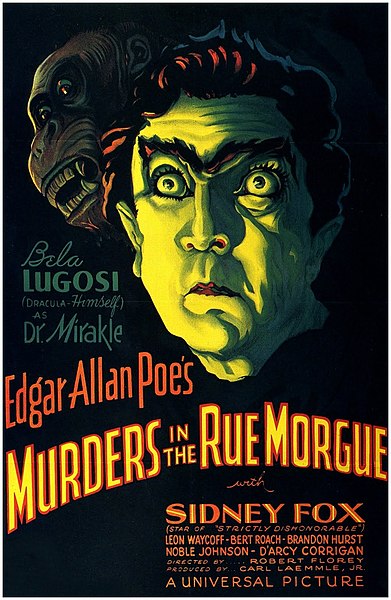 |
| Credit: Wikimedia Commons/Harry Clarke |
Warning: There are unavoidable spoilers in this review. The only way to avoid them is not to read the review (until you’ve read the book and seen the movie, of course).
Edgar Allen Poe is not only known as an early author of American horror but also America’s first detective writer. His short story, “The Murders in the Rue Morgue”, combine elements of horror and detective fiction. The story contains gothic elements, a killer ape and methodical crime investigation. The earliest full-length movie adaptation of the story is Universal’s 1932 version directed by Robert Florey. In this movie adaptation a mad scientist is added to the story who does more of the killing than the ape, yet the original basic plot is maintained.
The Short Story
Poe’s “Murders in the Rue Morgue” involves a couple of gothic amateur detectives, one by the name of Auguste Dupin and the other the narrator who, as with many of Poe’s stories, is mostly left unnamed. The two men, are gothic in that they rent and reside in a secluded, decaying mansion, keeping the windows shuttered during the day and only going out at night. In a sense, they are vampiric with out the bite (literally).
Dupin and the narrator are what many literary experts have call “arm chair” detectives. That is, they mostly resolve the case from the comfort of their home. However, the grisly details of the murders are still laid out even if through the newspaper article the two detectives initially investigate the murders through. Eventually, however, they go to the scene of the crime which is an apartment where two women’s corpses had been found: one stuffed up a chimney and the other laying mutilated in the garden below. They struggle to solve the mystery of the grisly killings, an attempt that even the Parisian police have not been able to carry out successfully because of the complexity of the crime. Dupin and the narrator eventually conclude from evidence that the killer was not human but an escaped Ourang-Outang.
The Movie
 |
| Credit: Wikimedia Commons/Universal |
The 1932 movie focuses more on the killings done by a mad scientist than by an ape. In this film the evil Dr. Mirakle, played by Bela Lugosi, kidnaps young women to torturously experiment on in an attempt to combine the blood of a human with an ape. The women die in the process. Still, Dr. Mirakle’s ape, in this movie a gorilla, goes on a killing spree of a sort and is even responsible for stuffing one of its victims up a chimney like in the short story. Dupin in this one is not so gothic, and is a medical student who is boyfriend to Mademoiselle Camille L’Espanaye (Sidney Fox) and so she, like her mother, play a much more present role unlike in the short story where both women are already found dead. Mirakle eventually kidnaps Camille in which Dupin takes up his amateur detective role to assist the police to find her before the mad scientist can do any harm.
So, while the mad scientist character and his evil ambition is an add-on to the story in this movie, the basic plot is kept. However, it’s kept in a loose sense because the main issue in the movie is Mirakle’s murdering of innocent women rather than the murders committed by the ape’s. Still the movie is suspenseful, disturbingly intense for its time while convincing, the atmosphere surrealistically gothic with its German-style of set design such as angled architecture exteriors and interiors, and is filmed with dark and light shadow techniques. Interestingly, the scene at the end shows the gorilla kidnapping Camille and climbing to the top of a three-story building--a lot like “King Kong” although the latter would not come out until about a year later. So, this scene may had been the inspiration for the ending scene in “Kong”.
The 1932 film adaptation of Poe’s “The Murders in the Rue Morgue” was made really good as its own movie. However, unlike the short story, the source of the murders is revealed early on not giving the viewers a chance to try to solve the mystery with the detectives. A good mystery encourages the reader to try to solve the crime before the detective can in which the movie doesn’t allow for. Still, visually, Robert Florey’s film is a sensation and Lugosi plays convincingly a character that you love to hate.
Have you read Poe’s “The Murders in the Rue Morgue” or seen any of the movie adaptations?
Until next time. . .
A little disappointing they revealed the mystery too soon. I vaguely remember the movie although it's been over forty years since I watched it.
ReplyDeleteStrangely, I don't remember having ever seen it before I watched it last week, so I think that was the first time.
Delete